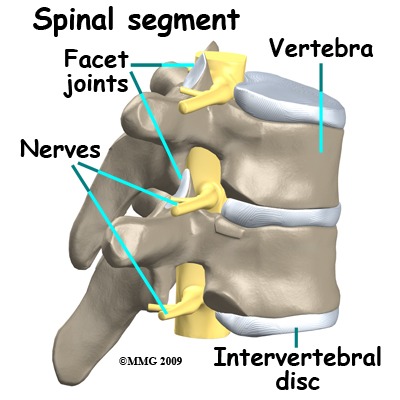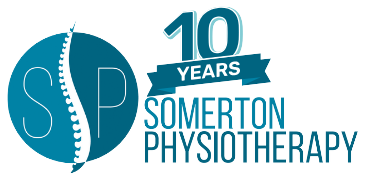Overview of Lower Back Pain
Approximately 80% of all adults experience back pain at some point in their lifetime. It is one of the most common causes of job-related disability and a leading contributor to work absenteeism in Ireland. A recent survey on back pain in Ireland, found that 68% of Irish people suffer from back pain at least once a week, and that a staggering 50% of adults in Ireland have suffered from back pain for more than five years. Back pain is so prevalent that financially it costs the country more than cancer and diabetes treatments combined.
Men and women are equally affected by lower back pain, which can range in intensity from a dull, constant ache to a sudden, sharp sensation that leaves the individual incapacitated. Pain can begin abruptly as a result of an accident or by lifting something heavy, or it can develop over time due to age-related or degenerative changes to the structures of the spine.
Anatomy of the spine and lower back:

The lower back, where most back pain occurs, consists of five vertebrae (referred to as L1-L5) which support much of the weight of the upper body. The spaces between the vertebrae are maintained by intervertebral discs that act like shock absorbers throughout the spinal column to cushion the bones as the body moves. Bands of tissue known as ligaments hold the vertebrae in place. Nerves branch off from the spinal column at each level of the spine. Theses nerves pass through small holes then connect together to form the Sciatic nerve, which travels into the lower limbs. When an individual reports that they have “Sciatica” it is these nerves that are trapped.
Causes of lower back pain:
Lower back pain has many causes. Most episodes of lower back pain are musculoskeletal in origin and can be treated with a course of Physiotherapy. Examples of the main causes of lower back pain include:
Sprains and strains to muscles or ligaments account for most acute lower back pain episodes. Both can occur from twisting or lifting something incorrectly, lifting something too heavy or overstretching your lower back.
Intervertebral disc degeneration is one of the most common causes of lower back pain and occurs when the usually rubbery discs lose integrity as a normal process of ageing. In a healthy back, intervertebral discs provide height and allow bending and extending of the lower back. As the discs deteriorate, they lose their cushioning ability.
Herniated or ruptured discs can occur when the intervertebral discs become compressed and bulge outward (herniation) or rupture, causing low back pain.
Radiculopathy is a condition caused by compression and/or inflammation to a spinal nerve root. Pressure on the nerve root results in pain, numbness, or a tingling sensation that radiates to other areas of the body. Radiculopathy may occur when a herniated or ruptured disc compresses a nerve.
Sciatica is a form of radiculopathy caused by compression of the Sciatic nerve. This compression often causes sharp low back pain combined with pain through the buttocks and down one leg, occasionally reaching the foot.
Spondylolisthesis is a condition in which a vertebra of the lower spine slips forward, pinching the nerves exiting the spinal column.
Spinal stenosis is a narrowing of the spinal column that puts pressure on the spinal cord and nerves that can cause pain or numbness with walking and over time may lead to leg weakness and sensory loss.
Scoliosis which is an abnormal curvature of the spine.
Osteoporosis leads to the bones of the spine becoming brittle and porous, making spinal compression fractures more likely.
Signs and symptoms of lower back pain:
There are several warning signs, known as ‘symptoms’, that may indicate that you are about to develop an acute episode of lower back pain. If you feel the onset of any of the below signs and symptoms it is important you consult your local GP or Chartered Physiotherapist.
Muscle ache or stiffness in the region of the lower back
- Pain that radiates down the lower limbs
- A sensation of pins and needles or numbness radiating into the lower limbs
- Limited flexibility or range of motion of the back – particularly in the morning time
- Disrupted sleep due to pain in your lower back
- Discomfort with sitting or driving
- Discomfort on bending or lifting
- Difficulty walking or exercising
Risk factors associated with developing lower back pain:
A risk factor is something that increases your chances of developing lower back pain. Having more risk factors means you have a higher chance of sustaining a back injury. I have highlighted the main risk factors below that your local GP or Chartered Physiotherapist will discuss in more detail with you.
Occupational – Prolonged standing or sitting, repetitive lifting or poor sitting posture and work ergonomics are all recognised as factors that contibute to the development of back pain.
Age – Studies have shown that the risk of lower back pain increases as an individual gets older. Back pain is the most frequent cause of the limitation of activity in people under 45 years old.
Family History – A family history of back pain has been shown to increase one’s risk.
Gender – The evidence here is confusing: Some studies have shown that males are at greater risk of developing lower back pain, while other studies suggest that females are more likely to develop this type of pain. Women who have had two or more pregnancies have a higher risk of developing lower back pain.
Level of Physical Activity – The strength and endurance of the back and abdominal muscles have been shown to be related to the development of back pain. Studies have shown that physical fitness and conditioning may help to prevent back injuries.
Obesity – While not conclusive, several studies have shown an increase in back pain in obese patients, especially in women.
Poor Posture and Alignment – Poor posture or improper alignment may predispose individuals to developing back pain over time as this can cause undue stress on spinal structures in the lower back.
Previous Back Injury – The single best predictor of back pain is a previous back injury. Evidence has shown that relapses are very common in individuals who do not treat their lower back pain in the correct manner.
Psychological / Social Factors – It is increasingly recognised that a wide variety of psychological and social factors can increase the risk of low back pain. Research has shown that anxiety, depression, stressful responsibility, job dissatisfaction, mental stress at work, and substance abuse can place people at increased risk for developing chronic low back pain.
Smoking – Studies have shown that smokers have a 1.5 to 2.5 times greater risk of developing lower back pain than nonsmokers. It is thought this may be due to reduced oxygen supply to discs and decreased blood oxygen from the effects of nicotine on constriction of the arteries.
Sports – Participating in sports such as skiing, snowboarding, gymnastics and contact sports such as GAA and rugby increase the participants risk for developing lower back pain.
Other factors – Other factors may play a part in the development of acute and chronic lower back pain. These include underlying spinal conditions such as osteoporosis, spondylolysis, discogenic disease, degenerative joint disease (osteoarthritis) of the spine and scoliosis.
Treatment of lower back pain:
Treatment choice for lower back pain generally depends on whether the pain is acute or chronic. Most episodes of lower back pain will respond favourably to a course of physiotherapy treatment. Early and accurate assessment and diagnosis is essential in order to prevent a worsening of symptoms. A Chartered Physiotherapist can provide a variety of treatments, help you understand your problem and help you get back to your normal activities of daily living pain free.
Manual therapy such as spinal manipulation or mobilisation and massage are often used to alleviate symptoms and manage lower back pain in the acute stage. A home exercise programme will be devised to help restore muscular strength and re-educate spinal movement patterns. Other modalities such as dry needling, acupuncture, electrotherapy or hot / cold packs may also be beneficial in relieving the symptoms of lower back pain. Preventative activities such as pilates or yoga are recommended to help keep your lower back in a healthy state and reduce the likelihood of a recurring episode in the future.
Summary of lower back pain:
- Back Pain is a very common complaint in Ireland
- Bed rest and inactivity are not helpful in the long-term management of lower back pain
- Lifting and bending are safe when carried out correctly
- Avoiding activities and moving carefully does not help your back in the long-term
- Poor sleep, high stress levels, low mood and worry influences back pain
- Supervised exercise (by a medical professional) is good and safe for you if you have back pain
- If you feel the onset of lower back pain it is important you contact your local GP or Chartered Physiotherapist as early intervention leads to greater outcomes
- A Chartered Physiotherapist is expertly placed to accurately diagnose and treat lower back pain.
If you are looking for a Physiotherapist to treat back pain in Dublin, you can book in to see one of our experienced Physio’s to get a more individualised assessment and treatment approach.
